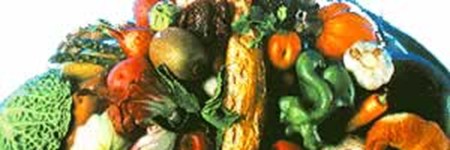High fibre diet
DEFINITION
The aim of the High Fibre Diet is to provide 25-35g dietary
fibre from a mixture of sources, both soluble and insoluble. It is
useful for the following conditions: constipation, diverticular
disease, varicose veins, hiatus hernia and to minimise the risk of
bowel cancer.
fibre from a mixture of sources, both soluble and insoluble. It is
useful for the following conditions: constipation, diverticular
disease, varicose veins, hiatus hernia and to minimise the risk of
bowel cancer.
DIET SHOULD BE HIGH IN
- Wholegrain foods (e.g. bran cereals, which are high in dietary
fibre) and breads (e.g. whole wheat grain breads). - Legumes (baked beans, cooked dried beans, cooked kidney beans,
cooked lentils). - Fresh fruit (e.g. apples, banana, orange, pear, prunes,
raisins, raspberries, strawberries) with skin and pulp intact. - Dried or stewed fruits (e.g. prunes, apricots, raisins).
- Root vegetables (e.g. carrots, turnips, potatoes).
- Raw or fresh vegetables (e.g. cabbage).
SAMPLE MEAL PLAN
The following diet has been suggested:
BREAKFAST
- 1/2 grapefruit.
- 3/4 cup rolled oats porridge with 2 tablespoons raisins.
- 2 slices whole wheat toast with jam.
- 1 cup skimmed milk.
- Coffee or tea if desired.
MORNING TEA
- 1 rolled oats cookie
- Water
LUNCH
- 1 cup vegetable soup.
- 1 lean hamburger patty on multi grain bun with 2 slices of
tomato and lettuce. - 1/2 cup baked beans.
- Apple.
- 1 cup skimmed milk.
AFTERNOON TEA
- Bran muffin if desired.
- 1/2 cup orange juice.
DINNER
- 90g broiled chicken
- 1/2 cup brown rice.
- 1/2 cup broccoli with cheese sauce.
- Salad comprising 1 cup lettuce, 1/8 cup cucumber, 1/2 tomato,
1/8 cup bean sprouts and 1 tablespoon salad dressing. - 1 slice pumpernickel bread.
- 1/2 cup strawberries with 1/2 cup plain low-fat yoghurt.
- 1 cup skimmed milk.
NOTES
- Drink at least 6 cups of water of liquids (e.g. fruit or
vegetable juices) each day. - Eat slowly, chewing your food thoroughly.
- Eat meals at regular intervals.

